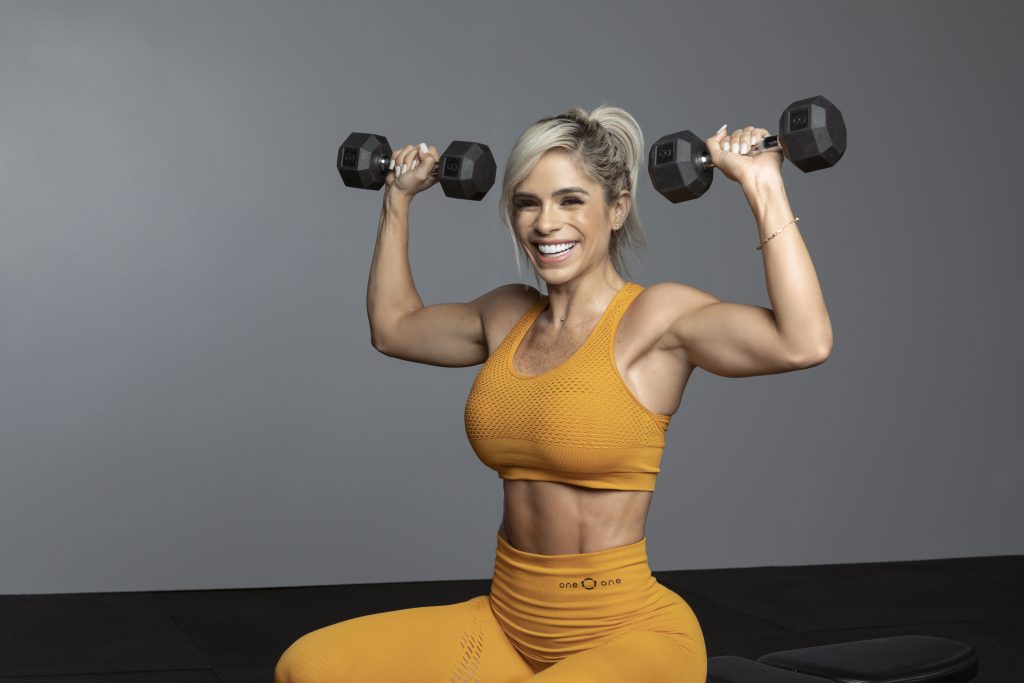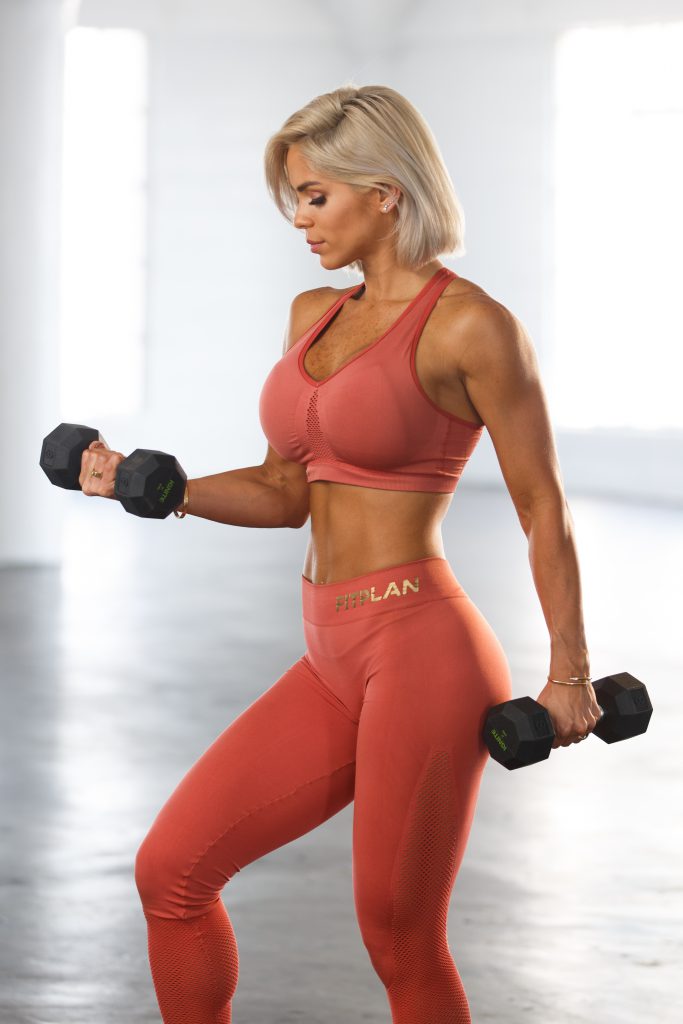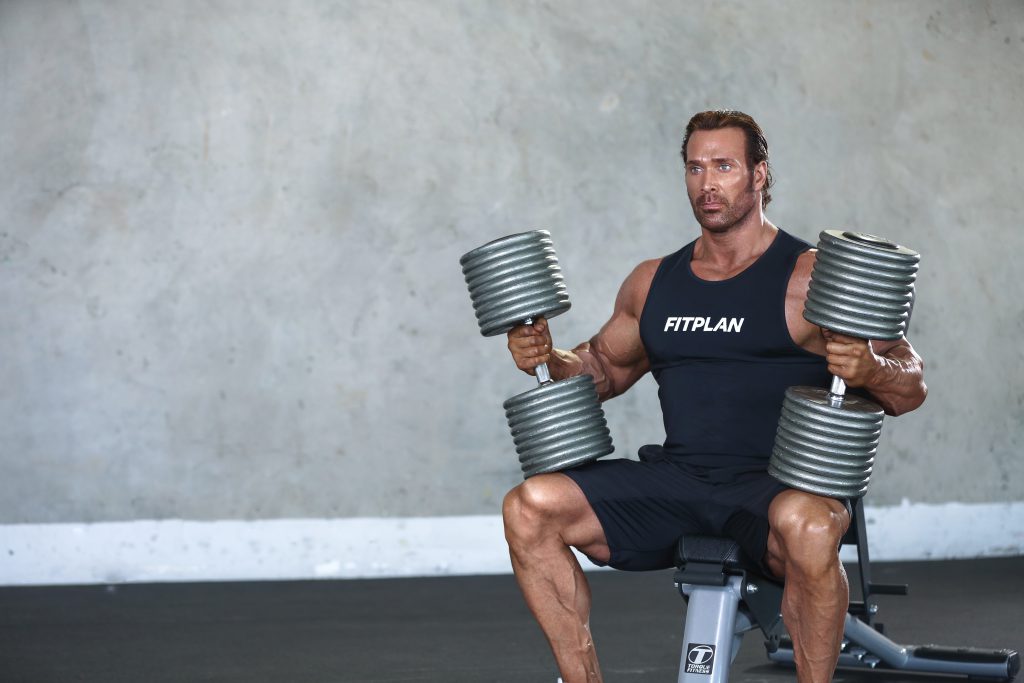Dumbbells are a great tool for quick, no-fuss strength training workouts. You can add them to bodyweight, banded, or lower-body exercises for an extra upper-body workout or you can use them as stand-alone weights to build muscle in your arms, shoulders, and back.
Target your triceps, biceps, shoulders, and back with the dumbbell workout in this guide to get a ripped upper body and tons of functional strength. Since the tools you need are portable, these exercises are optimal for fitness outside the gym. Use some of the recommended variations to keep things fresh and make sure your body stays at peak hypertrophy.
(Note: Want our elite trainers to help you tone and strengthen your upper body? Start your Fitplan free trial today!)
Benefits of Dumbbell Workouts
Portability is one of the most obvious advantages of dumbbells compared to larger weights like barbells or the awkward shape of dumbbells and medicine balls. Dumbbells also build muscle differently than barbells. One study from the Journal of Sports Science and Medicine found that dumbbell flyes caused greater activation of the biceps brachii than a barbell bench press.
Dumbbells might require more stabilizing energy than barbells, but they also allow for a slightly wider range of motion. You can also perform many more single-arm exercises with dumbbells than you can with a dumbbell.
If you’re trying to build a bigger chest, dumbbells activate the pectoralis major to a greater extent than barbells do. To keep things interesting, your weekly workout routine should blend barbell and dumbbell exercises. But there are plenty of great dumbbell exercises to constitute a powerful upper-body workout on their own as well.
How to Build Muscle Fast With Dumbbells
The main thing you should do if you want to build muscle with dumbbell exercises is to keep your routine varied. Change up your rep count, up the intensity factor by increasing weight, or use smaller exercises and short breaks to eliminate downtime with a HIIT routine.
Don’t neglect your macronutrients, either. If you want to build muscle, you have to have a modest caloric surplus so your body has the energy it needs to increase hypertrophy and create more muscle mass. Make sure more of those calories are coming from protein, the building blocks of muscle.
For the most part, eliminating carbohydrates is not going to do you any favors. Not only will you be missing out on a great way to build a caloric surplus into your diet, but you’ll also be depriving your body of the glycogen it needs to power through high-intensity strength training such as dumbbell exercises.
Lastly, remember to give yourself rest days. It’s all good and well to feel the burn and be sore the next day, but give the muscle groups in your upper body some time to heal to avoid injury and increase muscle mass.
Helpful hint: Try a guided home workout with a professional trainer in our Dumbbells at Home Fitplan!

Best Dumbbell Exercises for a Ripped Upper Body
Add a few of these upper-body exercises to your weekly workout routine for huge arms and broader shoulders.
1. Hammer Curls
Do this classic move with a pair of dumbbells to build the long head of the biceps and important muscles like the brachialis and the brachioradialis. That means hammer curls help you get higher peaks so your biceps are visibly larger and they also increase the functional body strength of your arms that helps stabilize the wrist and elbow joints.
In addition to these benefits, hammer curls also have several variations that target different parts of the arm in new ways. The simplicity of the traditional hammer curl and the majority of its variations make them all good options for a home workout.
To perform hammer curls with proper form, stand with your feet shoulder-width apart and keep a slight bend in your knees. Take a dumbbell in each hand and make sure your palms face your torso. Tuck your elbows into your sides and lift the dumbbells up to your shoulders. Return to the starting position to complete one rep.
Hammer Curl Variations:
You can mimic the movement of a traditional hammer curl using an EZ-bar or combine the move with a lower-body exercise like a lunge. If you’re concentrating on your upper body, try doing hammer curls one arm at a time and slowly rotating your arm back and forth throughout the move.
2. Arnold Press
Build boulder shoulders with the Arnold press, which targets all three parts of the deltoids on the top of your shoulders. This is an overhead move that will move your arm shoulder muscles in a fairly unique way that more common dumbbell exercises won’t.
Take a set of dumbbells in your hands and hold them in front of your chest. Tuck your elbows into your shoulders to make sure the dumbbells are in the right place. They should be at shoulder level and in line with your shoulders.
Turn the weights so that your palms face your body. The forearm should be in line with the elbow, not slanted. Once you’re in the right starting position, raise the dumbbells over your head by moving them out to the side and then lifting. As you do so, rotate your arms so that your palms face outward.
As you reverse the movement back to the starting position, make sure your palms get all the way back around again. The biggest mistake most people make with the Arnold press is curving their shoulders so that their arms are misaligned or the weights are too close together. You should also take care not to rotate your arms too quickly.
Arnold Press Variations:
The Arnold press is already a variation of the shoulder press, which is essentially the same except for skipping the rotating action and moving straight up and down. You can add a core and lower back workout by sitting on an exercise ball while you do your Arnold Presses.
If you forget your dumbbells one day, try push-back push-ups for an effective bodyweight exercise that will still work your delts, chest muscles, and triceps.
Helpful hint: Burn fat and build muscle in your upper body with our Zero to Hero Fitplan!
3. Pullover
The movement might look similar to the Arnold press, but pullovers change the perspective and target chest muscles like the pectoralis major as well as the lats, which are in your upper back. You need a flat bench for this exercise but you’ll only need one dumbbell. You can go with a heavier dumbbell since you’ll be holding onto it with both hands.
If you’re looking for a dumbbell exercise that will build your core strength as well as highly visible upper-body muscles, the pullover is exactly what you need. To do this exercise, lie down on a flat bench and plant the soles of your feet flat on the floor. Hold the dumbbell sideways by gripping one of the weights instead of the center bar.
Lift the dumbbell directly above your shoulders. You should be looking at the opposite weight when your arms are fully extended. Move the weight backward and away from your body. Lower it at the same time until it’s level with your head.
At the lowest point of this move, your arms should be straight and level with your body. If you were standing, the weight would be above your head. Reverse the movement to complete one rep.
Pullover Variations:
If you’re coordinated enough to move your arms together, you can also use a set of dumbbells for this exercise. Sit on an exercise ball if you don’t have a flat bench to lie down on. For added difficulty, anchor resistance bands to a point behind you and wrap them around the weights for more tension toward the beginning and end of each rep.
4. Dumbbell Rear-Delt Flye
Reduce your risk for shoulder injuries with this easy move. It also needs a flat bench, so if you were already using one for the pullovers we just talked about, the rear-delt flye is a natural follow-up move. This exercise targets the rear delts, which is great for stability and functional strength.
Sit on the end of a flat bench, chair, or medicine ball. The soles of your feet should be flat on the ground and you should have a dumbbell in each hand with your palms facing your body. Hinge at the hips and lean forward with your back straight until your upper body is at a 45° angle.
With your arms in a dead hang, the dumbbells should be just above ankle-height. Move each weight out to the side until they reach shoulder height, then return to the starting position. Keep a slight bend in your elbows to prevent them from locking out completely.
The dumbbell rear-delt flye is meant to prevent shoulder injuries, but that only works if you can go through the motions at a reasonable pace. If you’re just starting out, take it slow until you know you have the form mastered and then speed up a bit.
Rear-Delt Flye Variations:
You can do this move standing up, on a pec deck machine, face-down on an incline bench, single-handedly, or with resistance bands attached to the weights. Some mixture of all these variations throughout your workout routine will lead to the best strength gains and shoulder muscles that are strong enough to protect the sensitive joint from painful injuries.

5. Biceps Curl
No dumbbell workout is complete without a few sets of biceps curls. It’s a favorite among gym rats and simple enough to use as part of a workout or for filling intervals in a HIIT routine. Beyond making your upper arms look massive, biceps workouts also help move the shoulder and can prevent injury there.
You might have seen this exercise done standing up or sitting down. There isn’t a huge difference between the two, but if you’re doing a single-arm variation with heavier weight it might be easier to sit down. Sitting also helps reduce the likelihood of form mistakes and prevents other muscle groups from stepping in and taking the strain off the biceps brachii.
Hold two dumbbells at your sides with your palms facing forward away from your body. Keep your back straight and lift the weights up until they reach shoulder-level and then lower back to where you started. Coordinate the lift so that both arms are moving at the same pace.
The key to executing a biceps curl properly is moving only your biceps. If your shoulders, back, or chest start moving, that means other muscles are taking over for the biceps. This is an isolation exercise for building huge biceps, so you don’t want any other muscles getting involved.
Biceps Curls Variations:
You can change this dumbbell biceps curl up by reversing your grip, lying on an incline bench, or rotating your arm throughout the exercise. Preacher curls and concentration curls are also common exercises that mimic the action of a biceps curl and build strength in the brachialis muscle as well as the biceps.
Helpful hint: Build stronger glutes and hamstrings alongside your upper body with The Perfect Fit Fitplan!
6. Overhead Triceps Extension
Focus on your triceps after your biceps curls for bigger muscles and more functional strength in your upper arms. Just like the biceps curls, the overhead triceps extension is simple enough to be used to fill intervals in a HIIT workout or to warm-up or cool down after a routine. If you’re aiming for triceps exhaustion, this isolation exercise is a great way to get there.
You can do this exercise standing or sitting down on a flat bench or exercise ball. Grab onto one end of a dumbbell with both hands and hold it behind your head. Your elbows should form at least a 90-degree angle in this starting position. Slowly raise the weight by extending your arms above your head.
Once your arms are fully extended, you can lower the weight down again. Practice this movement so that you can go through the full range of motion of the extension without moving your head. Your elbows have to be parallel to your face or else your triceps won’t get the full workout.
Overhead Triceps Extension Variations: If you have a resistance band that’s large enough, you can stand on one end and pull the other up behind you so that it attaches to the weight. This will increase the tension on your triceps throughout the move and it also makes a great replacement banded exercise in case you ever find yourself without a pair of dumbbells.
You might also prefer the sitting or lying triceps extension. The move is exactly the same except the starting position varies. For an extra challenge, you can also try the move with a dumbbell in each hand or you can concentrate on single-arm variants with more weight in just one hand.

7. Dumbbell Bench Press
The traditional bench press most of us are familiar with uses a barbell, but switching to two dumbbells allows for greater arm movement and develops more defined pecs. If you find that you can’t hold as much weight with dumbbells as you can handle with a barbell, it’s wiser to add more reps or sets than it is to strain with too much weight.
If you aren’t familiar with bench presses, make sure to have a spotter or a trained professional to spot you. If that’s not possible, start with less weight and advance very slowly to make sure you have the strength to lift the dumbbells.
This is a great exercise to pair with pull-ups. They both target similar arm and chest muscles, but the dumbbell bench press isn’t as much of a full-body exercise. If your lower body or back gets worn out before your pecs do, push them toward exhaustion with the bench press.
Lie on a flat bench with your feet flat on the ground and hold a dumbbell in each hand. Straighten your arms so the weights are directly above your chest. Slowly lower the weights until they’re level with your torso and then raise them again.
Dumbbell Bench Press Variations:
The best way to make this move more challenging is to attach a resistance band. That will cause strain throughout the movement rather than only in the second half. Just make sure you’ve practiced enough to handle the additional strain.
How to Build a Complete Upper-Body Dumbbell Workout
Use four or five of the exercises we just listed to build a routine that meets your fitness goals. Each exercise should be done 10 times in a set, 1 – 2 sets per visit to the gym. If you have more time, you can always move it up to 3 sets or 15 reps per set.
As we mentioned before, the most important thing to remember is to give your upper body a rest so it can build muscle. Don’t risk overtraining and ruining your hard-earned gains.
Helpful hint: Try our 90-Day Advanced Challenge to burn fat and get massive strength gains!
Conclusion:
Dumbbells are one of the most convenient workout tools around. You can use them to replace gym days entirely or sneak in a workout at home or the office. Use the exercises and variations in this guide to get a ripped upper body with dumbbells in no time.
(Note: Want our elite trainers to help you kickstart your new routine? Start your Fitplan free trial today!)


